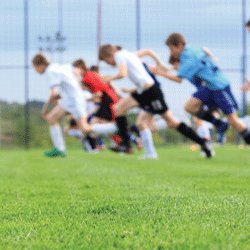Many athletes are now coming to the end of the competitive season. Those involved in traditional team sports have been training and competing for 8-9 months! It is important for athletes at all levels to build down time into their yearly training. For the majority this will be the off season period, and can last anywhere between 2-8 weeks typically. Taking a break from the physical, mental and emotional pressure of formal training and competition allows the athlete to rejuvenate. Failing to build in adequate rest and recuperation has been linked to increased incidence of injury, over training and drop out from sports.
The off season period doesn’t have to involve doing no physical activity. Indeed, complete inactivity is probably detrimental to the athlete if prolonged. The old adage that a change is as good as a rest holds true. Taking time to engage in a range of different physical activities can maintain an element of physical fitness without adding to the specific strains associated with an athletes sport.
All Eyes on Fitness in Pre-Season Training
Refreshed from the off season break, athletes enter pre-season training with all thoughts on building fitness for the upcoming competitive season. At the amateur level this can mean so called ‘beastings’. Gruelling fitness sessions aimed at maximising fitness in a very short period of time. For teams that may only train once per week this habit is hard to shake. Old school thinking – get as much ‘bang for your buck’. At the professional and elite levels, athletes should arrive at pre-season training in reasonable fitness. The build up of fitness will be done more scientifically for those who’s job it is to stay fit and healthy.
Whilst the start of every competitive season has athletes and coaches thinking about the year ahead, there is an argument for adopting a longer term perspective. This is especially true for young athletes. Olympians will train and compete in four yearly cycles. Each year building upon the last with the aim of achieving peak fitness at the Olympic Games. Professional athletes can have careers that last 15 years or more at the top level. Young athletes that progress to the senior level may compete for several decades! Therefore, each pre-season should blend from the off season and into the competitive season. There can be no argument that the pre-season window represents the most time efficient window to work on fitness – but it shouldn’t be the whole focus. Equally, fitness shouldn’t be neglected during the competitive season.
Training for Peak Performance
Viewing each year as a separate entity may be detrimental. It can be very challenging for an athlete to adopt a longer term perspective during pre-season training. Especially, when managers and coaches may be under pressure to succeed. Examples of poor practice may be introducing specialised training methods before the basics have been exhausted / maximised. Another example may be keeping an athlete playing for too long because the coach is thinking of the result rather than the medium term health of the athlete. Those of us involved at junior levels of sport, along with amateur levels, should focus primarily on the health of our athletes. Keeping a squad healthy during pre-season and the competitive season allows a consistency in selection. This will far outweigh the ‘get fit quick’ gains of high intensity plyometrics in a squad that doesn’t consistently do enough strength training!
Fitness for peak performance is something where athletes can exert some personal responsibility. At NK Fitness we work hard with all of our athletes to ensure that they are constantly progressing. Not every session is concerned with achieving a PB. However, every session can be used to ensure that the athlete learns something about themselves that they can then use in competition.
